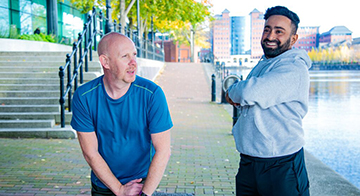As a social species, we rely on social interactions to feel connected to others and to make sense of our place in the world. In fact, research has shown that social contact with others is important for both our mental and physical wellbeing.
Studies show that people who have strong social connections tend to have lower rates of depression and anxiety and are more resilient to stress1. Other research demonstrates that social connections can have a positive impact on our mental wellbeing, as well as our physical health, by improving cardiovascular health, boosting the immune system, boosting brain function2 and even increasing lifespan.3
Social interaction is important to help us live a longer and happier life. So how can executives ensure that they’re prioritising social interaction, at work and beyond, for their own benefit and to boost the health and wellbeing of their employees?
Social interaction in the workplace – a new dynamic
“Business leaders have a real opportunity to lead from the top when it comes to prioritising social interaction opportunities. Everyone’s busy at work, but by setting aside time to socialise – and engaging in initiatives themselves – executives can demonstrate that social interaction is a valuable part of working life.”
– Naomi Humber
Social interaction at work can be just as important as time spent with friends and family. It can help to build strong and productive teams, improve communication and collaboration, and foster a sense of community within an organisation4. But for many, the opportunities for social interaction have fundamentally changed since the pandemic.
Watercooler moments are fast disappearing in a remote-first world, and even if employees are physically together, lingering anxiety from COVID-19 can mean that people are not rushing back to social situations.
According to Naomi Humber, Clinical Psychologist and Head of Mental Wellbeing, Bupa UK, it’s vital that organisations find ways to foster social interaction and connection among their employees, even when they’re not physically together. One approach is to encourage social events and activities, such as virtual - or in person - coffee breaks, happy hours, or team building exercises. Another option is to provide opportunities for employees to connect with one another in more structured ways, such as through mentorship programs or cross-functional project teams.
She says: “Business leaders have a real opportunity to lead from the top when it comes to prioritising social interaction opportunities. Everyone’s busy at work, but by setting aside time to socialise – and engaging in initiatives themselves – executives can demonstrate that social interaction is a valuable part of working life.”
Employees themselves can also take steps to stay connected with their colleagues and build social connections within the organisation. This can include reaching out to co-workers to schedule coffee or lunch breaks, or volunteering to be a part of a team or project that allows for more social interaction. Naomi continues: “It may be helpful to actively seek out opportunities to connect with others, such as joining employee resource groups or participating in social events organised by the company.”
Understanding the types of social interactions.
There are many different types of social interactions, including:
- Cooperation: This refers to working together towards a common goal. Cooperation can involve collaboration, teamwork, and shared decision-making.
- Conflict: This occurs when two or more people have conflicting goals or beliefs. Conflict can be constructive, helping to identify and resolve issues, or it can be destructive, leading to tension and strained relationships.
- Conformity: This refers to the tendency to follow social norms or go along with the majority. Conformity can be helpful in building social cohesion, but it can also limit creativity and individuality.
- Social exchange: This occurs when people engage in interactions that involve some sort of exchange, such as trading goods or services. Social exchange can involve negotiation and decision-making, and it is a key aspect of many social interactions.
Each type of social interaction has its own benefits and drawbacks. Cooperation can help to build teamwork and collaboration, while conflict can lead to the resolution of issues and improved communication. Conformity can help to build social cohesion, but it can also limit individuality. Social exchange allows for the exchange of resources and ideas, but it can also involve competition and power dynamic. It can be useful to understand the different types of interactions you might encounter, and assess how you might respond to them.
Social anxiety
While social interaction is undoubtedly important, many people struggle with social anxiety – something which the pandemic may have exacerbated. According to Dr Humber “Social anxiety can manifest in different forms, from feelings of self-consciousness and embarrassment, to physical symptoms such as sweating, shaking, and a racing heart5. These symptoms can make it difficult for individuals with social anxiety to participate in meetings, make small talk with co-workers, or network at social events.”
There are, of course, a variety of factors that can contribute to social anxiety in the workplace - including previous negative social experiences, perfectionism or performance anxiety, and a fear of being judged or rejected by others. Naomi continues: “Everyone’s experience is likely to be unique, and it’s important to understand the underlying causes of social anxiety in order to develop effective strategies for managing it in the workplace.”
Strategies to help
There are several strategies that can help individuals with social anxiety cope with the challenges of the workplace and beyond. Naomi says: “Seeking support from a mental health professional, such as a therapist or counsellor can be an important first step in addressing social anxiety. Practicing relaxation techniques, such as deep breathing and meditation, can also be helpful in managing anxiety symptoms. Gradually exposing oneself to social situations and building confidence can also be an effective strategy, as can setting achievable goals and celebrating small wins along the way.”
Combatting loneliness
It's also important to appreciate the benefits that social interaction can bring. For example, social interaction can help to reduce feelings of isolation and provide connection and support. To get more social interactions into your day-to-day life, consider joining groups or organisations that align with your interests and hobbies, such as classes or volunteer organizations. It can also be helpful to reach out to friends and family and make an effort to connect with them on a regular basis.
Getting the most out of social interactions
Of course, when you're in social situations, it's crucial to maximize the benefits of these interactions. For example:
- Be present and fully engaged in the conversation. This means putting away distractions like phones or laptops and actively listening to others.
- Be respectful and open-minded when interacting with others and try to find common ground and shared interests.
- Be proactive in seeking out social opportunities and building relationships with others. This can help to strengthen your social connections and improve overall wellbeing.
Each type of social interaction has its own benefits and drawbacks. Cooperation can help to build teamwork and collaboration, while conflict can lead to the resolution of issues and improved communication. Conformity can help to build social cohesion, but it can also limit individuality. Social exchange allows for the exchange of resources and ideas, but it can also involve competition and power dynamic. It can be useful to understand the different types of interactions you might encounter, and assess how you might respond to them.




